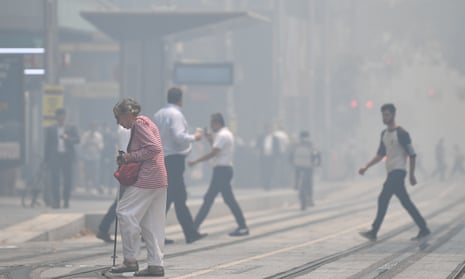Smoke pollution that blanketed Australia’s south-east for many months during the bushfire crisis may have killed more than 400 people, according to the first published estimate of the scale of health impacts – more than 10 times the number killed by the fires themselves.
The figures, published in the Medical Journal of Australia, are “definitely alarming”, according to Chris Migliaccio, who studies the long-term effects of wildfire smoke at the University of Montana in Missoula and was not involved in the research.
Lead author Fay Johnston, an epidemiologist at the University of Tasmania in Hobart, estimates 80% of Australia’s population of about 25 million was blanketed by smoke this summer.
“The fires were unprecedented in Australia’s history, in terms of vast amounts of smoke, the huge populations affected by the smoke and the long duration,” she said.
Sydney experienced 81 days of poor or hazardous air quality in 2019, more than the total of the previous 10 years combined.
“When you’re affecting millions of people in a small way, there are going to be enough people at high enough risk that you’re going to see really measurable rises in these health effects,” Johnston said.
As data on hospital admissions, deaths and ambulance callouts was not yet available to researchers, Johnston and her team instead modelled the likely medical consequences of the pollution, which is the “the only other way to get a quick ballpark idea of the health impacts,” she said.
To come up with a picture of the overall health burden of smoke exposure, they looked at existing data on death rates and hospital admissions to get a baseline. They then modelled how the known levels and extent of smoke exposure across the southeast, during the height of the crisis from 1 October to 10 February, would have affected these.
Their results estimate that over this period there were 417 premature deaths, 3,151 extra hospitalisations for cardiorespiratory problems and 1,305 additional attendances for asthma attacks. This compares to 33 who reportedly died as a direct result of the bushfires.
Many of the deaths and hospitalisations are likely to have been older patients with heart disease or lung problems, such as chronic bronchitis or emphysema – but severe asthma attacks will likely have resulted in deaths in younger people too, Johnston said.
In patients with pre-existing cardiorespiratory issues, smoke exposure promotes inflammation, stresses the body and makes blood more likely to clot, increasing the risk of a heart attack. “In someone at high risk, subtle changes due to stress … can be the precipitating factor for a very serious or terminal event,” she said.
Guy Marks, a respiratory physician and epidemiologist at the University of New South Wales in Sydney who was not involved in the research, said the findings “highlights the importance of the health consequences” and is useful in estimating fire-related deaths that may not have been recognised as the result of smoke exposure.
The findings concur with previous studies of the health consequences of wildfire smoke in North America, but the numbers “are more drastic, potentially as a result of the unprecedented nature of the exposure,” Migliaccio said. He added that while previous studies found increases in hospital visits, the addition of large numbers of premature deaths in the Australian study is significant and disturbing.
Migliaccio said that due to climate change increasing the frequency and severity of wildfires “these types of exposures are increasing in number and intensity, making this kind of research vital.”
To look into just such effects, a consortium of 10 air pollution researchers from across Australia, led by Marks and including Johnston, have already put up their hands for $3m in government funding, which became available in the wake of the crisis.
The research proposal, funding of which has yet to be confirmed, aims to plug significant gaps in knowledge about the health impacts of bushfire smoke and how these might be mitigated.
Marks says that questions he and his colleagues hope to address include whether there is anything unique about health effect of air pollution caused by bushfires, what the long-term effects of exposure are, and what the effects might be on newborn babies and pregnant women.
The researchers – all members of a collaborative consortium, The Centre for Air Pollution, Energy and Health Research (CAR), funded by Australia’s National Health and Medical Research Council – also hope to study whether it’s possible to filter air to make indoor refuges safe from pollution, and if public health advice can be improved.
